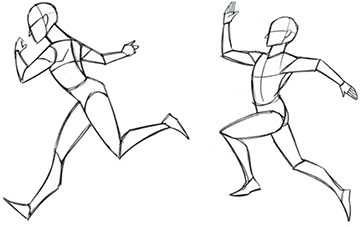Posture
The types of characters you see in a space western don’t overlap much with the sort you’d expect in the clean, cold environment inhabited by a starship crew. There are a lot of different ways to get across those differences, but one of the easiest (and most effective) is to adjust your character’s posture.

PERSONALITY DIFFERENCE
These two men have exactly the same height and build, but the way they’re standing sets them apart even before you add clothes. The man on the left has a rigid posture, with a straight back and his chin up. The man on the right is slouching; his spine is curved, and he’s relaxed. Take a good look at both of them, and think about what assumptions you might make based on their posture alone.

REACTIONS TO A SITUATION
Posture can help show a character’s personality, but it can also show the way the same character reacts in different situations. Try drawing a bored character who’s seated and waiting for a friend. Now try drawing the same character, still seated, but waiting to be called in for a job interview. What changes did you make?

EVERYDAY ACTIONS
You can use posture to imbue personality into everything your character does. Walking, running, fighting, eating, reading a book—every act your character performs will have physical tells that can show the viewer something about them. Sketch a character running, then sketch the same character running a different way. What does the pose say about the character in each case? Which is closer to the idea you want your viewers to take away?